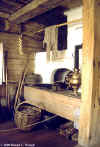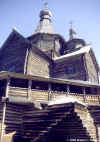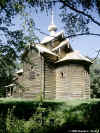The Vitoslavlitsy Museum of Wooden Architecture
Return to Novgorod home page.
[Photos at bottom of page. All images are thumbnailed.]

 South of Novgorod and not far from the outlying Iur'ev
Monastery is an outdoor museum of wooden architecture. It is one of several to be
found now in Russia (others are in Suzdal and Kostroma), where often quite old buildings
have been dismantled in their original locations, brought to the museum, reassembled and
restored. The "villages" which result are, of course, artificial
creations, since they never existed in the given location with the same grouping of
buildings that one now sees. However, an obvious effort has been made to
ensure authenticity at least in the houses, which have been furnished with genuine objects
and in which items have been placed according to what is known from ethnographic surveys
of still living traditions which can reasonably be assumed to correspond to those of the
former inhabitants of the houses on display. Granted, the houses have a kind of
museum cleanliness about them that surely could not have been typical of homes actually
being lived in. The attendants dress in authentic regional costume (perhaps the
Sunday best, rather than workaday clothes?), and at various times in the year there are
folk festivals attempting to recreate the atmosphere of traditional holidays. The
Novgorod Museum web pages have some photos of such festivals at the Vitoslavlitsy Museum.
South of Novgorod and not far from the outlying Iur'ev
Monastery is an outdoor museum of wooden architecture. It is one of several to be
found now in Russia (others are in Suzdal and Kostroma), where often quite old buildings
have been dismantled in their original locations, brought to the museum, reassembled and
restored. The "villages" which result are, of course, artificial
creations, since they never existed in the given location with the same grouping of
buildings that one now sees. However, an obvious effort has been made to
ensure authenticity at least in the houses, which have been furnished with genuine objects
and in which items have been placed according to what is known from ethnographic surveys
of still living traditions which can reasonably be assumed to correspond to those of the
former inhabitants of the houses on display. Granted, the houses have a kind of
museum cleanliness about them that surely could not have been typical of homes actually
being lived in. The attendants dress in authentic regional costume (perhaps the
Sunday best, rather than workaday clothes?), and at various times in the year there are
folk festivals attempting to recreate the atmosphere of traditional holidays. The
Novgorod Museum web pages have some photos of such festivals at the Vitoslavlitsy Museum.
The Novgorod exhibit brings together churches of serveral distinct designs
from as early as 1531 (a date one can hope is verified in written sources), houses from
the nineteenth century, and a windmill from the early 20th century. The districts
represented are quite diverse, among them Novgorod, Liubotino, Borovichi Khvoinitskii, and
Kresttsy. One can see where modern beams have replaced ones which had rotted away (as one
of the attendants told me, the walls tend to be intact, but the ceilings and outbuildings
often suffer from the damp). One could not go inside the churches, where, in
any event, presumably the original icon screens had not been preserved. One
interesting question about authenticity concerns the issue of whether the exteriors of the
churches were always bare logs, or whether, as William Brumfield has noted on the basis of
extensiveobservation in the Russian north, they may not in fact from early times have been
covered with boards which later "restorers" decided were in-authentic and
stripped away.
One is struck by the substantial size of the houses, which indeed is true
of many villages in the Russian north. They were often intended to accomodate
several generations of a family, birth rates were high, and many of the families in fact
were quite prosperous. The living quarters were confined largely to one room, with a
partition dividing off the kitchen area, dominated by a stove on the top of which the
elderly and young children would sleep. Traditionally the benches around the side of
the room doubled as beds (the metal bed in one of the displays is an admittedly late but
authentic addition to the furnishings). Most houses in earlier times lacked
chimneys; so the stove was stoked, filling the room with smoke, then the windows opened to
clear the air. There is good evidence to suggest this practice contributed to
serious health problems. However, as with the bed frames, chimneys came with
"progress," as one can see in the house built in 1882 that was in the village of
Ryshevo. The houses contain evidence of popular religion--naturally an icon corner,
but also under it a display of rye or oat sheaves as a fertility "offering" and
in one of the homes a sprig of field herbs in the beams (not shown in the photos) to ward
off evil spirits. In this connection one might note as well the lone birch tree not far
from the 1595 Church of the Dormition, whose branches are covered with strips or cloth or
plastic, reminiscent of the numerous springs and shrines in the Muslim world where prayer
"flags" are tied to branches. The displays in the houses have ample
evidence of the importance of flax cultivation and processing, something which still goes
on in the Novgorod region--the last of the photos below shows high quality hand-made and
hand-embroidered linens being displayed at a stand just outside the entrance to the
museum.
An integral part of the houses was the shed/barn, where hay and other farm
produce would be stored, where some of the processing of food took place, and where the
farm animals would live in the cold months. One of the photos displays the
woven nests for chickens, a wooden harrow and a two pronged plow (sokha) that was
typical in central and northern Russia. Of course the museum setting lacks the
authentic aromas of a working farm, where people lived side-by-side with the animals.
The pictures below are intended to document as many as possible of the
buildings in the museum. Identifications have been provided, but I am not in a
position to offer specific ethnographic or architectural commentary. All photos are
thumbnailed; clicking on each image will bring up an enlargement.

windmill,
Ladoshchina,
Soletskii dist.
20th c. |

houses,
Pyryshchy, Kresttsy dist.,
and Chastova, Novg. dist.,
19th c. |

Ch. of Nativity, Periodiki,
Borovichi dist., 1531;
house, Ryshevo,
Novg. dist., 1882 |

detail of
Ryshevo house |

interior of
Ryshevo house |

interior of
Ryshevo house |

interior of
Ryshevo house |

farm implements
in shed,Chastova,
Novg. dist. |

ch., Kashira, Malo-
visherskii dist., 1745; house,
Chastova, Novg. dist. |

ch., Kashira,
Malovisherskii dist.,
1745 |

Ch. of Nativity of
Our Lady, Periodiki,
Borovichii dist., 1531 |

Ch. of Nativity
detail |

Ch. of S. Nicholas,
Vysokii ostrov,
Okulova dist., 18th c. |

Ch. of Dormition
Nikulino, Lubytino
dist., 1599 |

Ch. of Trinity,
Lubytino dist, 1672-1676 |

Ch. of Dormition,
Kuritskoe, Novg.
dist., 1595 |

Ch. of Dormition,
detail |

Ch. of Dormition |

Ch. of S. Nicholas,
Miakishevo, Khvoi-
nitskii dist., 17th c. |

Ch. of S. Nicholas
from SE |

Ch. of S. Nicholas,
Tukholia, Kresttsy dist.
1688 |

Ch. of S. Nicholas
from SW |

Novgorod's fine linen
embroidery today |
Return to Novgorod home page.
© 2000 Daniel C. Waugh. Last revised October 29, 2000.

 South of Novgorod and not far from the outlying Iur'ev
Monastery is an outdoor museum of wooden architecture. It is one of several to be
found now in Russia (others are in Suzdal and Kostroma), where often quite old buildings
have been dismantled in their original locations, brought to the museum, reassembled and
restored. The "villages" which result are, of course, artificial
creations, since they never existed in the given location with the same grouping of
buildings that one now sees. However, an obvious effort has been made to
ensure authenticity at least in the houses, which have been furnished with genuine objects
and in which items have been placed according to what is known from ethnographic surveys
of still living traditions which can reasonably be assumed to correspond to those of the
former inhabitants of the houses on display. Granted, the houses have a kind of
museum cleanliness about them that surely could not have been typical of homes actually
being lived in. The attendants dress in authentic regional costume (perhaps the
Sunday best, rather than workaday clothes?), and at various times in the year there are
folk festivals attempting to recreate the atmosphere of traditional holidays. The
Novgorod Museum web pages have some photos of such festivals at the Vitoslavlitsy Museum.
South of Novgorod and not far from the outlying Iur'ev
Monastery is an outdoor museum of wooden architecture. It is one of several to be
found now in Russia (others are in Suzdal and Kostroma), where often quite old buildings
have been dismantled in their original locations, brought to the museum, reassembled and
restored. The "villages" which result are, of course, artificial
creations, since they never existed in the given location with the same grouping of
buildings that one now sees. However, an obvious effort has been made to
ensure authenticity at least in the houses, which have been furnished with genuine objects
and in which items have been placed according to what is known from ethnographic surveys
of still living traditions which can reasonably be assumed to correspond to those of the
former inhabitants of the houses on display. Granted, the houses have a kind of
museum cleanliness about them that surely could not have been typical of homes actually
being lived in. The attendants dress in authentic regional costume (perhaps the
Sunday best, rather than workaday clothes?), and at various times in the year there are
folk festivals attempting to recreate the atmosphere of traditional holidays. The
Novgorod Museum web pages have some photos of such festivals at the Vitoslavlitsy Museum.





















